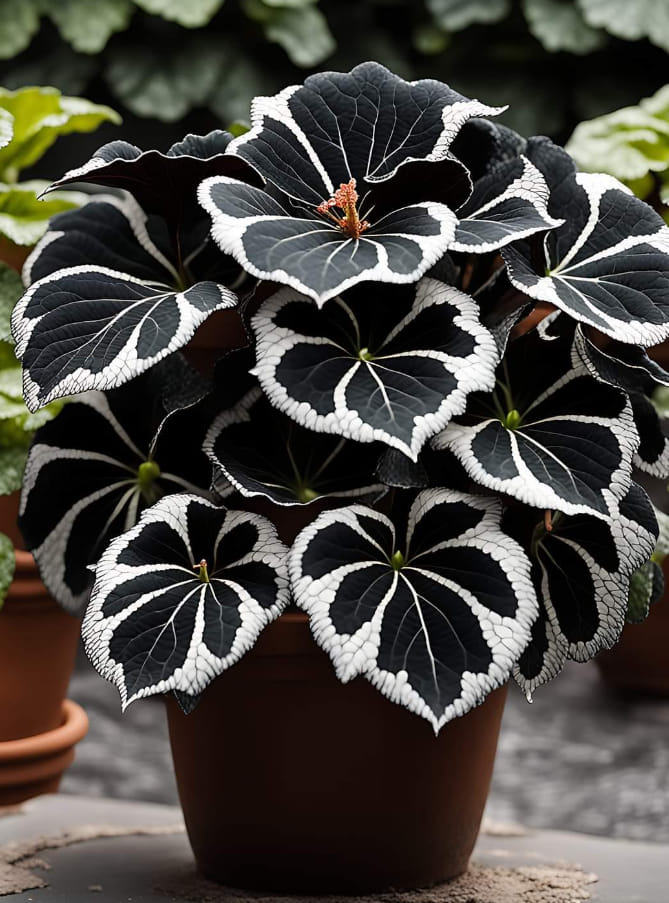The Black Velvet Begonia (Begonia masoniana) is one of the most captivating plants you can add to your indoor collection. Known for its striking black velvet leaves that feature intricate white veins, this plant stands out with its dramatic appearance and unique beauty. Its dark foliage and white veining create an artistic contrast that makes it a showstopper in any room. Whether you’re a seasoned gardener or a beginner, caring for the Black Velvet Begonia is relatively simple, as long as you follow a few essential guidelines. Here’s a complete care guide to help you keep this stunning plant thriving.
Light Requirements: Bright, Indirect Light is Key
The Black Velvet Begonia thrives in bright, indirect light. While it can tolerate lower light levels, it will not flourish as well, and its dramatic foliage may lose its intensity. To ensure it gets the right amount of light, place it near a window with filtered sunlight, or use sheer curtains to protect the plant from direct, harsh sunlight that may scorch its delicate leaves.
Be sure to avoid placing it in a spot where the sunlight is too strong, as this can cause the leaves to burn. A spot with bright, indirect light will encourage healthy growth and allow you to enjoy the full beauty of the Black Velvet Begonia’s deep, velvety leaves and intricate white veins.
Watering: Consistent Moisture Without Overwatering
Watering is one of the most crucial aspects of caring for the Black Velvet Begonia. This plant prefers soil that is consistently moist but not soggy. Overwatering or allowing the plant to sit in water can lead to root rot, a common issue for begonias.
To determine when to water, check the top inch of soil; when it feels dry to the touch, it’s time to water. Make sure to water thoroughly, ensuring that the water reaches the roots, but avoid leaving water in the saucer under the pot to prevent waterlogging. During the growing season, water regularly, but in the winter months, you can reduce the watering frequency as the plant enters a period of slower growth.
Soil: Well-Draining Potting Mix is Essential
The Black Velvet Begonia requires a well-draining potting mix to thrive. It prefers a soil mix that retains some moisture but allows excess water to escape easily. A standard indoor potting mix combined with perlite, orchid bark, or sand can help improve drainage. Avoid using heavy or clay-based soils, which retain too much moisture and can lead to root rot.
If you’re potting the Black Velvet Begonia, be sure to use a pot with drainage holes to help prevent water from collecting at the bottom, ensuring the roots have good airflow and won’t become waterlogged.
Temperature: Ideal Range Between 60-80°F (16-27°C)
This begonia variety enjoys moderate temperatures and thrives in environments ranging from 60-80°F (16-27°C). It is sensitive to cold temperatures, so it’s essential to keep it in a warm environment, particularly during the winter months. Avoid placing it in areas where the temperature can fluctuate too much, such as near air conditioning or heating vents, as this can stress the plant.
During the colder months, be sure to keep the Black Velvet Begonia indoors, as it will not survive frost or extreme cold conditions.
Humidity: Moderate to High for Best Growth
The Black Velvet Begonia prefers moderate to high humidity. It is a tropical plant, so mimicking its natural humid environment will help it grow lush and healthy. Ideally, the humidity levels should be above 50%. If you live in a dry area, consider placing the plant on a humidity tray or using a room humidifier to increase the moisture in the air.
Alternatively, you can group plants together to create a microclimate of higher humidity. Mist the leaves occasionally, but avoid excessive moisture on the foliage, as this can lead to fungal issues. Ensuring proper humidity will enhance the Black Velvet Begonia’s growth and vibrancy, allowing it to showcase its rich, dramatic foliage.
Fertilizing: Feed During the Growing Season
To keep the Black Velvet Begonia healthy and encourage optimal growth, use a balanced, water-soluble fertilizer during the growing season (spring and summer). Feed the plant once a month or as per the manufacturer’s instructions to ensure it receives the essential nutrients it needs.
Be sure to dilute the fertilizer to half the recommended strength to avoid overfeeding, which can lead to root burn. During the fall and winter months, when the plant’s growth slows, you can reduce or completely stop fertilizing, as the plant enters a resting phase.
Repotting and Pruning: Keep It Looking Beautiful
Like many begonias, the Black Velvet Begonia does not need frequent repotting. It’s best to repot the plant every 1-2 years or when it outgrows its pot. When repotting, choose a slightly larger pot with good drainage to accommodate the plant’s growing roots. This will ensure it has enough space to continue thriving.
Pruning is minimal but can help maintain the shape and health of the plant. If you notice any dead or damaged leaves, remove them to allow the plant to focus its energy on new growth. You can also trim back leggy growth to encourage a bushier appearance and more compact growth.
Common Issues: Troubleshooting Black Velvet Begonias
While the Black Velvet Begonia is a relatively easy plant to care for, there are a few common issues to watch for:
Yellowing Leaves: This can indicate overwatering or insufficient drainage. Make sure you’re not watering too frequently and that the soil is draining properly.
Brown Leaf Tips: This is often a sign of low humidity. If the tips of the leaves turn brown or crispy, try increasing the humidity around the plant or misting it lightly.
Leaf Spotting or Mold: Excessive moisture on the leaves or poor airflow can cause fungal issues. To prevent this, avoid watering directly on the leaves and ensure good ventilation around the plant.
Conclusion: The Black Velvet Begonia’s Bold Beauty
The Black Velvet Begonia is a must-have for any plant enthusiast looking to add a touch of drama, elegance, and unique beauty to their collection. With its striking black velvet leaves and intricate white veins, this plant is an eye-catching focal point in any space. By providing the right conditions, including bright, indirect light, consistent moisture, and moderate humidity, you can ensure this captivating begonia thrives and remains a beautiful addition to your home or garden.
By following the care guide outlined above, you’ll be able to enjoy the bold, contrasting colors and rich texture of the Black Velvet Begonia for years to come.
More Recipes You Might Like
-
Texas Toast Sloppy Joes: The Crunchy, Cheesy Upgrade You Didn’t Know You Needed
There’s something timeless about sloppy joes. For generations, this saucy, savory, and slightly sweet ground beef sandwich has been a go-to comfort food in American kitchens. It’s quick, filling, and family-friendly—perfect for busy weeknights. But what if we told you there’s a way to take this classic dish up a notch? Enter the Texas Toast…
-
Classic Pig Pickin’ Cake
When it comes to Southern desserts, few sweets shine as brightly as the Classic Pig Pickin’ Cake. This nostalgic cake, sometimes called a “Mandarin Orange Cake,” has roots deep in Southern tradition. It gets its playful name from its frequent appearance at pig pickin’s—Southern-style barbecue gatherings where communities come together to enjoy slow-cooked pork, sides,…
-
Lemon Garlic Butter Chicken with Creamy Parmesan Pasta
There’s something irresistible about the combination of tender, golden-browned chicken paired with a creamy pasta coated in Parmesan cheese. Add the brightness of lemon, the depth of garlic, and the richness of butter, and you have a recipe that feels indulgent yet approachable enough for a weeknight dinner. Lemon Garlic Butter Chicken with Creamy Parmesan…



